

What is a broach in Sailing?
Anyone who's been boating for some time will likely have heard the term "broach", something sailors try to avoid at all costs. But what exactly is broaching, what causes it to happen and how can we avoid them occurring?
A broach is a sailing or yachting term for when a boat unintentionally and involuntary gybes or changes course towards the wind, resulting in a loss of directional control and the vessel's rudder becoming ineffective. A broach can happen as a resulting effects of wind or wave action.
What is a Wind Broach?
A wind broach happens when a boat is sailing downwind and the sail, often a spinnaker, is overpowered by a gust of wind. This causes the boat to heel (or lean) a yacht further than anticipated, causing the rudder to lift out of the water. This results in the boat becoming uncontrollable and rounding up unexpectedly, the mainsail then gybes across the boat at a dangerous speed. As the boat turns into the wind and heels over it can lay the boat fully on its side, filling the cockpit with water or even in the most extreme cases, capsizing the vessel. This is not only dangerous but often frightening for the crew.
Watch video examples of sailing yachts broaching due to wind conditions:
Chinese gybe on a Farr 40
A major broach and Chinese gybe
IRC boat round down and broach under spinnaker
What is a Wave Broach?
A wave-based broach can happen to any vessel (motor or sailboats) that is going in the same direction as the waves. As the wave picks the boat up and increases the speed, the rudder can become affected by by the stern being lifted out of the water by an overtaking wave. In such cases the vessel is likely to sway across the waves and roll to one side, knocking the vessel completely on its size and, in extreme cases, potentially capsizing the vessel altogether.
Here are some examples of a wave-based broach.
An example of a ship broaching
A further explanation here
A large wave causes a motorboat to flip
What is a Spinnaker Broach or Chinese Gybe?
A broach, Chinese gybe or crash gybe are a sailing term for a dangerous situation that can occur when sailing downwind with a spinnaker.
During a spinnaker broach, the spinnaker can become caught in the wind and start to swing out to one side. If the boat is not turned quickly enough to keep the spinnaker under control, it can swing all the way around to the other side of the vessel with the mainsail crossing the boat quickly and dangerously.

A Chinese gybe occurs when the upper section of the mainsail moves across, filling from the opposite side, whilst the lower section of the mainsail and boom remain on the opposite side. This is unlike a normal gybe where the whole sail moves across the boat as the stern moves through the wind. A Chinese gybe is usually the result of too little tension on the kicker or vang which enables the boom to rise up, enabling the leech of the sail to twist extensively.
How to Avoid Broaching
The good news is there's plenty you can do to avoid this situation. The best way to avoid broaching is to keep the boat sailing at a constant angle to the wind. This can be done by trimming the sails correctly and adjusting the boat's course as needed. If the boat starts to heel too far to one side, the wind will catch the sails on that side more, which will cause the vessel to move more quickly in that direction. To prevent this, the sailor should adjust the sails and course to keep the boat sailing at a constant angle to the wind.
Here's a handy video from Yachting World on " How to avoid a Chinese gybe when sailing downwind ".
There are several ways to avoid broaching while sailing downwind. One way is to
- Keep the boat sailing as close to the wind as possible. This can be done by using a smaller jib or by sailing a narrower path.
- Use a preventer - a preventer is a line that is attached to the boom and runs to the deck of the boat. This line can be used to keep the boom from swinging out and causing the boat to broach.
- Keep your spinnaker trim on point and under control - be ready to depower it at a moment's notice
- Ease the pole forward and pull the kicker on as needed to keep power in the mainsail
How to avoid broaching on a motorboat
If you're more of a motorboat lover here how can you avoid broaching in tricky conditions?
- Keep one hand on the helm and one hand on the throttle at all times so you can control speed instantly
- Read the conditions and weather ahead - look for breaks in the swell before turning
- Use engine tilt and trim when running downwind with the waves
- If in doubt, go out and spend some time on your boat to better understand the limitations in different weather conditions
Watch a useful video on how to deal with big seas.
Sailing Broach Recovery
If the boat does start to broach, the sailor should first try to adjust the sails and course to correct the problem. If that does not work, the next step is to ease the sails on the side that is causing the boat to broach. This will help to slow the boat down and prevent it from capsizing. Finally, the sailor should try to steer the boat back into the wind and adjust the sails and course as needed.
If a broach does occur, there are several ways to recover. One way is to head up into the wind and let the sail fill with air. This will help to right the boat but is only achievable if you still have steerage. Another way to recover is to release the jib sheet and let the sail flap in the wind which will also help to right the boat.
- Think clearly - it can be scary when broaching but taking the wrong actions can make everything worse. Ensure your crew know who will make all the essential decisions should a broach occur to ensure clear directions and reduce panic reactions.
- Blow the halyard - if you decide to drop the spinnaker it needs to be dropped far enough that the wind can be taken out of the sail and remove its power, but not so far that it ends up in the water, creating a big mess. One way to help with this is to put a mark on the halyard to help the crew know where the limit is in an emergency.
- Hold onto the guy! - it's important you don't let the guy go any further than the pole on the headstay because if you do the spinnaker will be able to power up even with the halyard released which will prevent the boat from bearing away.
- The jib - consider leaving the jib up after you bear downwind as it can help you bear away when recovering from a broach
We hope this article will help you better understand broaching, what causes it, how you can avoid getting into a broach situation and how you can recover from it in a level headed fashion should it occur.
Stay informed, stay safe, and stay savvy!
savvy navvy , the boating app that brings all essential marine information together in one place. Featuring global charts, wind and weather forecasts, tidal graphs, GPS Tracking, automatic weather routing, and marina and anchorage information. It’s like Google Maps for boats.
Inspired to get on the water? Start your free trial today.
Latest Articles.
7-day greece cruising itinerary.
Imagine crystal blue waters with so much depth you can drop anchor right off the shoreline, calm flat waters that are almost mirror-like in reflection and Instagram-perfect flamingo floating sceneries. You would be forgiven for thinking I’m talking
How to Read A Nautical Chart Depth? A Step-by-Step Guide
Reading the depth on a nautical chart depth can be challenging for a beginner boater. However, with a step-by-step guide, it can be easy to get to grips with.
How to Calculate Nautical Miles On A Chart? All You Need to Know
Distances at sea are measured in nautical miles which are different to land miles. To measure distance on nautical charts, you will need a nautical ruler or dividers, which are specifically designed for use with charts. Calculating nautical miles on
Yachting Monthly
- Digital edition

How do I get out of a severe broach?
- James Stevens
- December 12, 2021
If your boat was about to broach what would you do? James Stevens answers your Questions of Seamanship

What would you do if your boat broached? Credit: Graham Snook/Yachting Monthly
James Stevens answers your Questions of Seamanship.
Dave is cruising from Port Edgar up the east coast of Scotland .
The boat is a 10m cruiser racer and conditions are ideal; sunny with a Force 4 from the west-southwest.
Dave is a proficient dinghy sailor but has only recently taken up yachting. His crew are keen but have limited offshore experience.
The boat is on a broad reach, and Dave decides that it’s time to hoist the symmetric spinnaker .
After a couple of false starts, with sheets through rather than over the rail, it goes up and their speed increases by 1-2 knots.
An hour or two later, Dave notices the speed has increased by another 1-2 knots, but conditions are still pleasant and the crew are enjoying fast sailing.
Continues below…

Spinnaker masterclass: tailored downwind sailing
There’s more than one way to rig, hoist, set and drop your spinnaker. Choosing the right setup and skills is…

How would you retrieve a spinnaker sail?
What is the best way to retrieve a spinnaker sail? James Stevens answers your questions of seamanship

How to cope with gusts and squalls
Spikes in wind strength can range from a blustery sail to survival conditions. Dag Pike explains how to predict which…

Sailing in waves: top tips to keep you safe at speed
Sailing in waves can make for a jarring, juddering experience and long, uncomfortable passages and at worst, a dangerous, boat-rolling…
The sea state has become rougher and the wind has moved further aft.
The apparent wind is a comfortable 10 knots but when Dave switches the instruments to true wind, it’s gusting 18 knots.
It is now getting difficult to steer, with the sea picking up the stern and accelerating the boat into the wave in front.
The crew are excited by the action but Dave knows the spinnaker has to come down soon.
At that moment a gust and an extra large wave appear and the boat accelerates.
The helm loses control and they round up in a spectacular broach.
The boat is heeling right over to starboard, pinned down with the spinnaker and main boom in the water, the rudder useless and the crew hanging on as best they can.
What does Dave do now?
The first action is to release the kicker and mainsheet to allow the boom to rise and depower the mainsail.

James Stevens, author of the Yachtmaster Handbook, spent 10 of his 23 years at the RYA as Training Manager and Yachtmaster Chief Examiner
This allows the boat to come upright enough to give steerage.
If the yacht is still on its side the spinnaker halyard can be eased about a third to half down, to take wind out of the sail but not too far.
It is really important not to immerse the spinnaker so the sheet should be tightened, which allows the wind to pass underneath.
The guy or sheet should not be released at this stage or the spinnaker will continue to pull the boat over and be hard to retrieve.
With the halyard eased, the helm can regain control and bring the boat upright by steering towards the spinnaker.
Once the course is downwind, the spinnaker can be dropped.
Taking the lazy guy between the foot of the main and the boom before releasing the guy brings the spinnaker safely into the lee of the main.
Dave must keep calm and the crew will have to concentrate. Finding the right rope is difficult while clambering over the cockpit.
An early reduction in sail would’ve been a good idea.
Enjoyed reading How do I get out of a severe broach?
A subscription to Yachting Monthly magazine costs around 40% less than the cover price .
Print and digital editions are available through Magazines Direct – where you can also find the latest deals .
YM is packed with information to help you get the most from your time on the water.
- Take your seamanship to the next level with tips, advice and skills from our experts
- Impartial in-depth reviews of the latest yachts and equipment
- Cruising guides to help you reach those dream destinations
Follow us on Facebook , Twitter and Instagram.

Home » Blog » Sail » Downwind sailing: 3 strategies for sailing downwind in comfort and style
Downwind sailing: 3 strategies for sailing downwind in comfort and style
By Author Fiona McGlynn
Posted on Last updated: February 7, 2023
Some of my happiest sailing memories involve downwind sailing: coasting along with the spinnaker up, blissfully basking in the afternoon sun. I’ve also had some uncomfortable downwind rides, like sailing along the Washington-Oregon Coast with a cross swell and gusts of 40 knots.
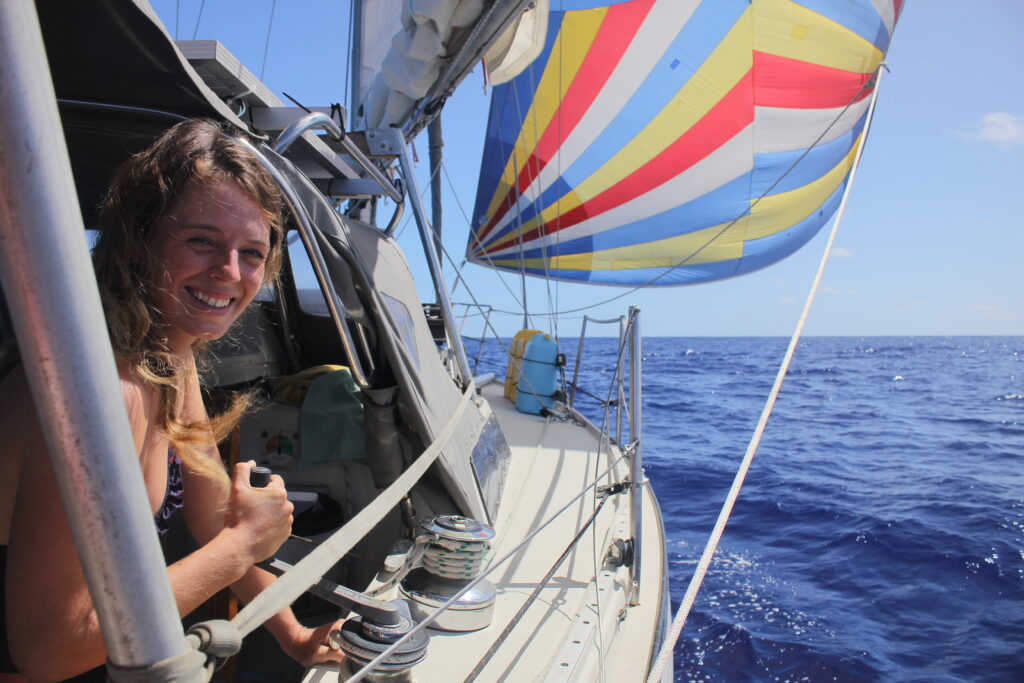
Sailing downwind can vary a lot, depending on the conditions, but having the right sail configuration and trim is key and can make all the difference to your comfort and safety.
Robin and I spent the better part of three years sailing (mostly downwind), but it wasn’t until we made a 26-day Pacific crossing to the Marquesas that we really refined our techniques—with none of modern life’s distractions we had a lot of time to think about it!
Below I’ll share the three downwind sailing configurations we used but first let’s quickly talk about the risks of downwind sailing (and how to minimize them).
What is downwind sailing?
Sailing downwind is sailing with the wind behind you. This includes broad reaching and running points of sail.
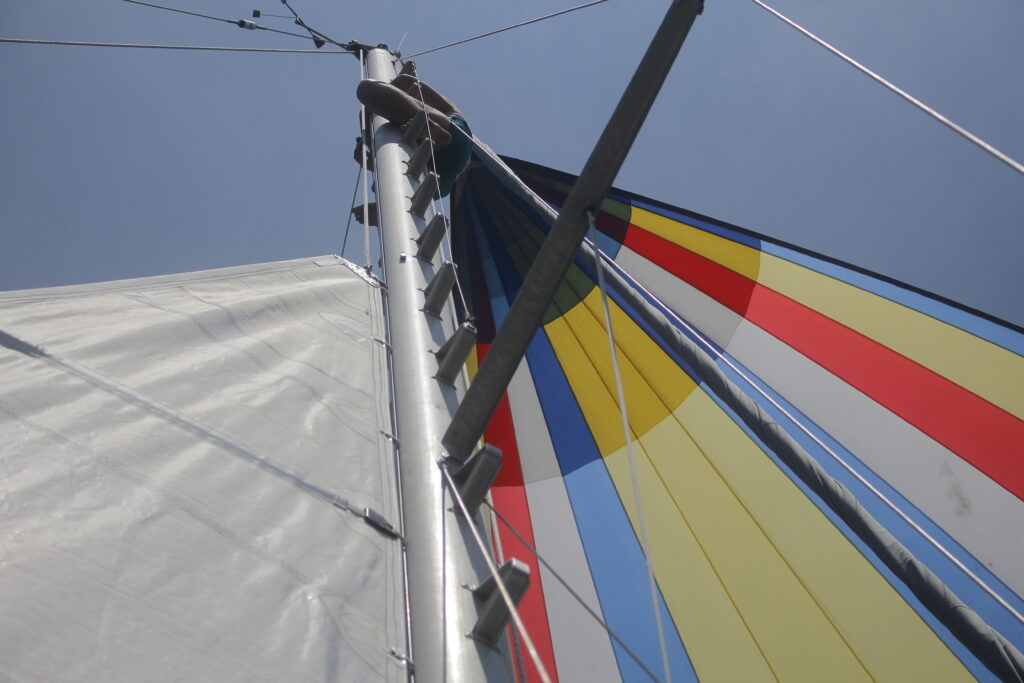
Risks of downwind sailing
Accidental jibes.
“Dead down, heads up” is an old piece of sailboat racing advice. When sailing downwind (especially dead downwind) you should be constantly aware of the potential for an accidental jibe—nobody wants to catch a boom in the face!
Accidental jibes happen fast, can cause severe injuries, and can even send you overboard. The substantial force also puts stress on the boat’s hardware, lines, and the boom itself and can result in broken equipment.
You can reduce the chance of an accidental jibe by not sailing on a dead run . Give yourself a margin for error, staying 5 to 10 degrees off dead downwind, in case the wind changes.
There are also a couple of systems that can reduce the risks associated with uncontrolled jibes.
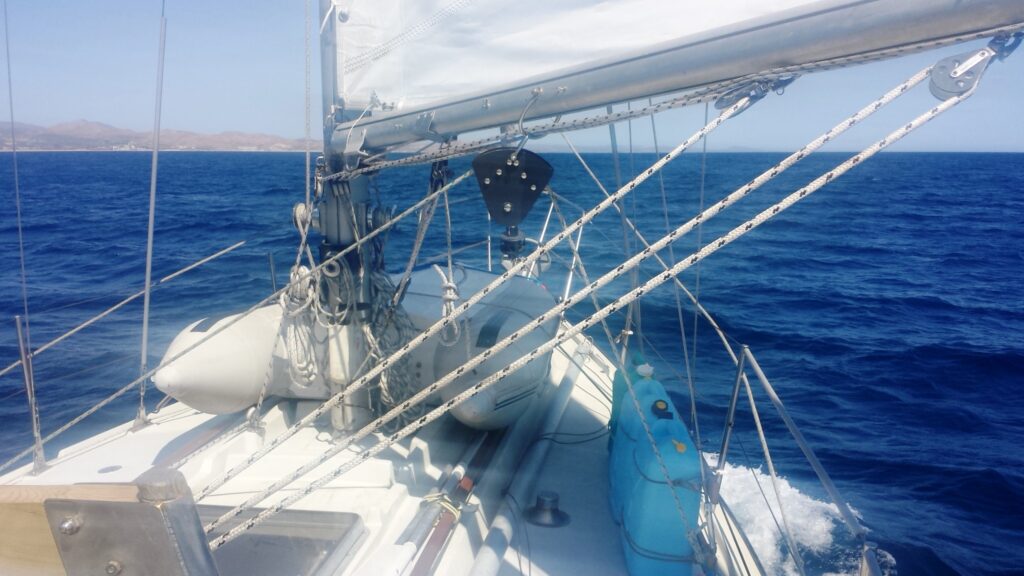
Preventers and boom brakes
Preventers work by “preventing” the boom from swinging at break-neck speeds across the boat’s centerline.
Preventers range from simple to complex and can get pretty expensive. However, you can rig a DIY boom preventer for next to nothing.
The simplest preventer setup is a line that runs from the end of the boom to a point on deck forward of the mast.
A boom brake is a more elegant solution that slows the boom as it crosses the centerline of the boat during a jibe. The big advantage over a preventer is that the boom isn’t held in a back-winded position if you accidentally jibe.
We were able to buy a second-hand Dutchman Boom Brake and we used it whenever the main was up. They’re expensive but a good investment if you’re planning on doing a lot of downwind sailing.
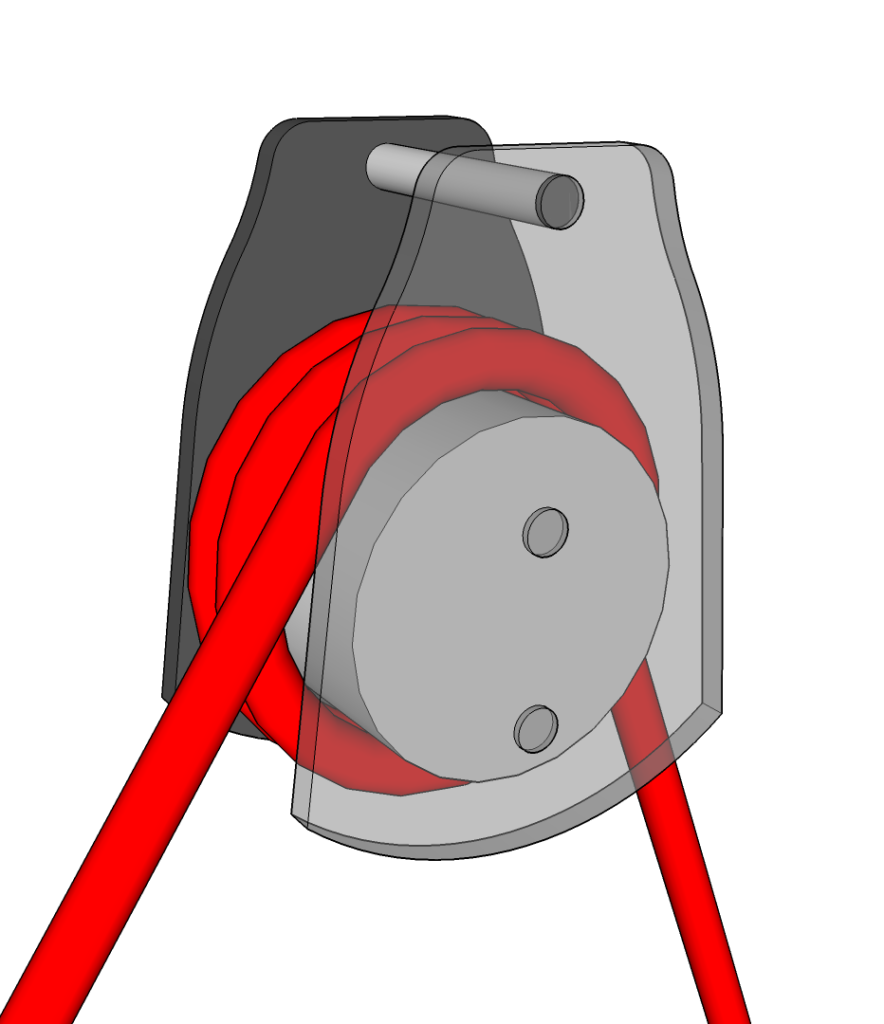
A broach is when a gust or a wave causes the boat to heel and twist violently into wind such that it can’t be counteracted by steering. In extreme cases, this may cause the boat to capsize.
There are a few strategies for avoiding a broach including not having too much sail area and carefully steering the boat to prevent rolling.
Downwind sailing setups and sail configurations
Over three years of bluewater sailing (almost all of it downwind) these were the configurations that worked best for us. Try these out on a calm day and keep tweaking until you find a balanced system that works for your boat and crew members.
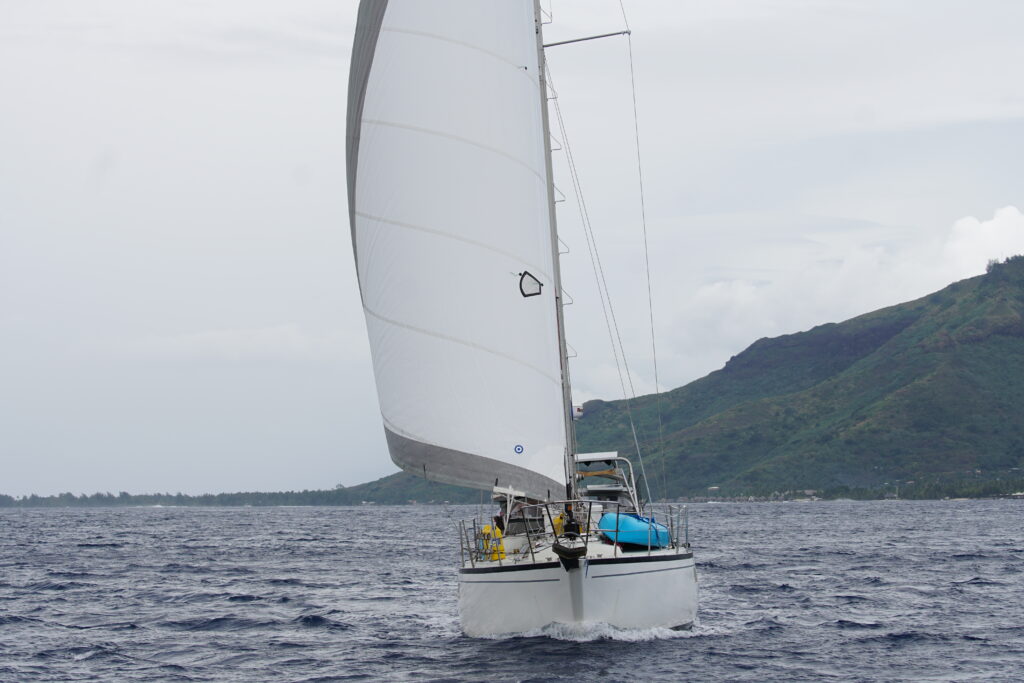
1. Sailing downwind on a headsail only
We’ll start with what is by far the simplest technique: sailing under a genoa or jib alone. Though it’s relatively uncommon to see a boat under headsail alone in your local harbor, we and many other bluewater sailors use this configuration with great success. Some even opt for twin headsails !
The benefits are that it moves your centre of effort forward and reduces weather helm, which can be a real advantage in strong winds. You also don’t have to deal with the mainsail’s wind shadow and it’s very simple to reef single-handed if you have a roller furler.
The drawbacks are a potential loss of speed, though really the genoa is your main engine when sailing downwind. Also, we typically used this configuration in heavy air when we were more concerned with boat stability than speed.
We used this technique for much of our sail down the Washington, Oregon, and California coastlines.
It was also a great technique for night sailing when we prioritized sleep over speed, and whoever was on watch could easily reef the genoa alone.
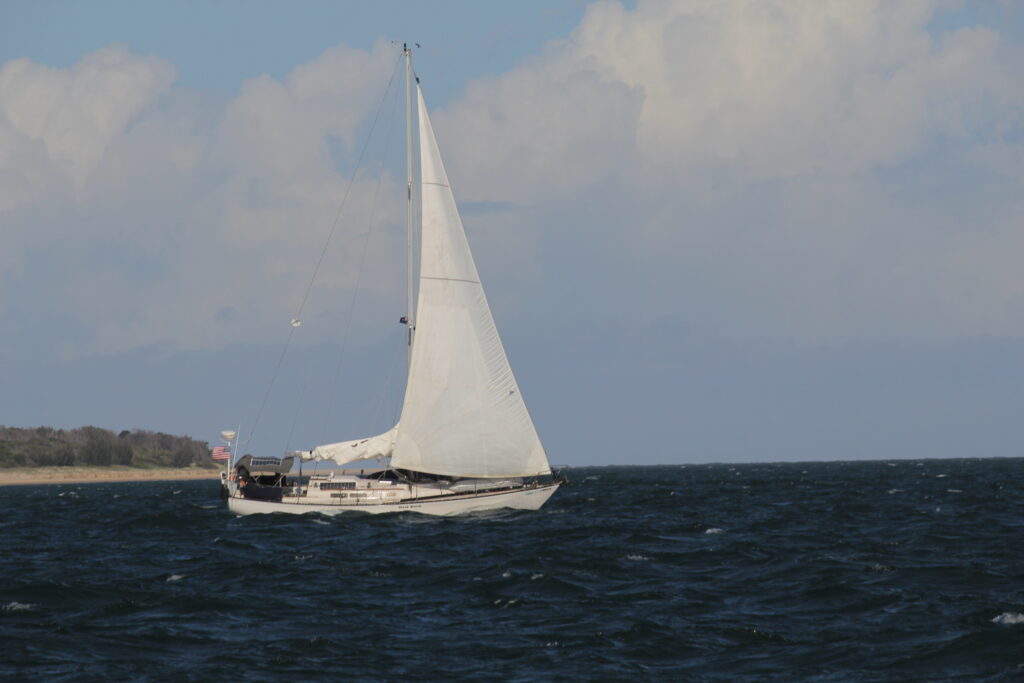
How to sail under headsail alone:
- Bear off to your desired point of sail.
- Unfurl your headsail (reefing as necessary).
- Trim your sail.
- Reduces weather helm which can be helpful with higher wind speed
- No blanketing from the mainsail
- Easy to set up and reef single-handed
- Potentially slower boat speed
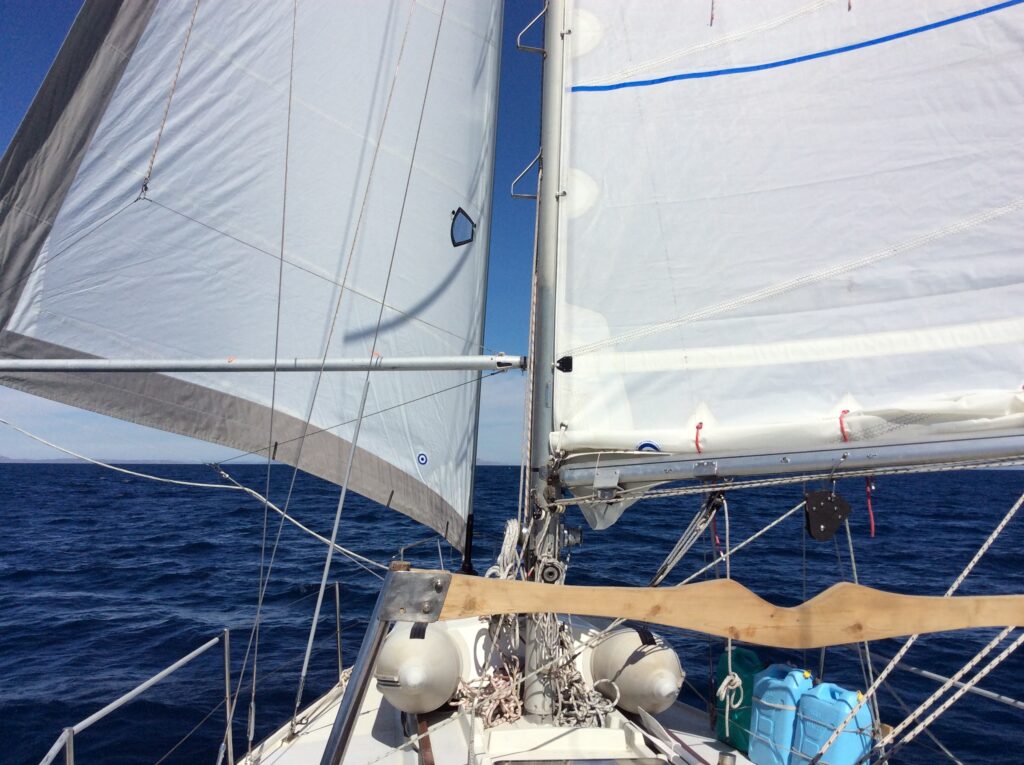
2. Sailing downwind with a mainsail and poled-out headsail
The further you bear off, the more you’ll find it difficult to keep the genoa filled. Eventually, you’ll reach a point where the main entirely blankets the headsail (around 140-220 degrees).
When running dead or near-dead downwind, we’d bring the genoa over to the windward side and go wing on wing. However, ocean swell and wind waves can play havoc with the headsail, especially in lighter winds, causing it to collapse and fill repeatedly, making a disturbing “whump” sound and shaking the mast.
In this scenario, we pole out our genoa. We only use this technique in open areas where we can hold a heading for an hour or more. If you need to jibe every 10 or 15 minutes (or less), most short-handed crews are going to find it’s not worth setting up a pole.
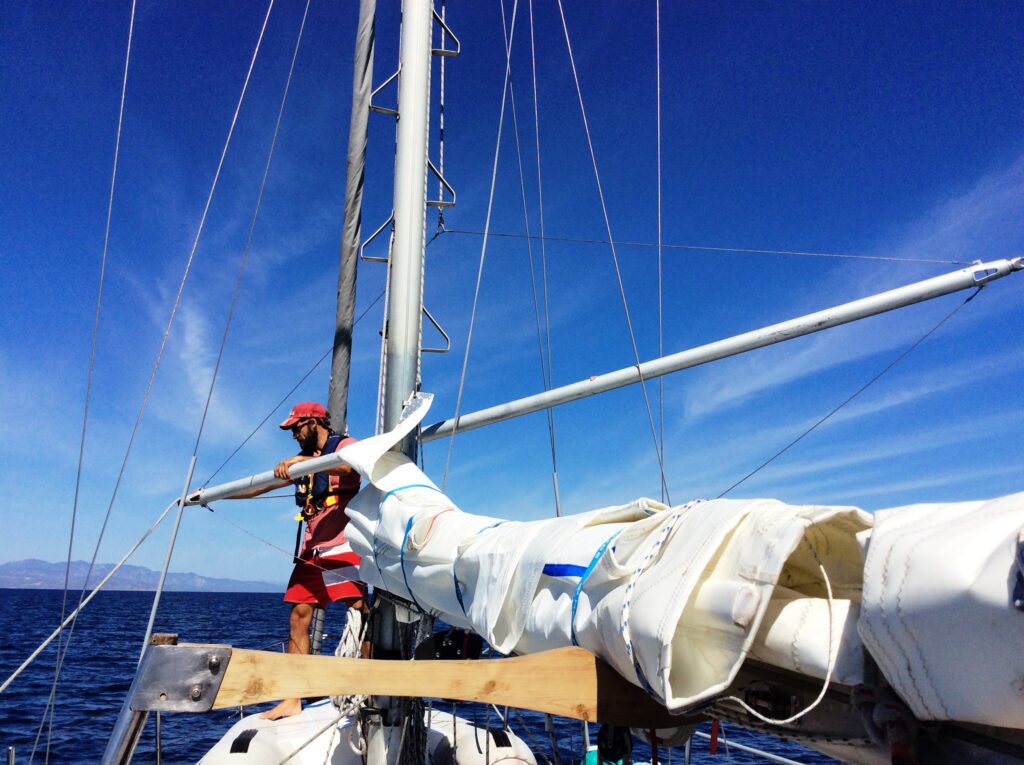
Spinnaker pole vs. a whisker pole
To do this you’ll need a spinnaker or whisker pole that is strong enough to handle the loads of a backwinded sail—check with a reputable source to choose the right whisker pole for your boat . Often, spinnaker poles run a bit short for a 120 to 150 percent genoa in which case a telescopic whisker pole can extend the full sail.
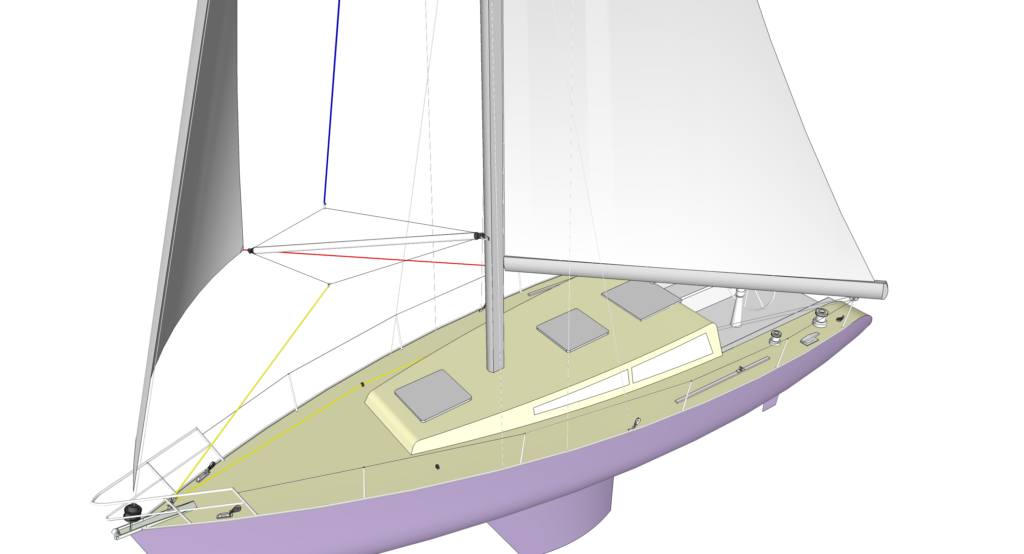
How to pole out a headsail
If you have any experience with poling out a spinnaker, you’ll find that it’s similar with a genoa.
- Start with a fully furled headsail.
- Attach the topping lift to the pole while it’s still on the deck.
- Raise the pole. A crewmate can take up slack as the pole is lifted so that the person on foredeck isn’t taking all the weight of the pole.
- Connect the foreguy, leaving a few feet of slack so that pole can move.
- Connect the outboard end of the pole to the jib sheet.
- Connect the inboard end of the pole to the mast.
- Level the pole (using the topping lift, foreguy, and mast track) with the clew of the sail.
- Adjust your pole to fit the sail. If you’re using a whisker pole, you can extend or shorten the pole. For a spinnaker pole, move the inboard end up and down the mast track to shorten it. Or, keep the pole level to push the sail out to its maximum.
- Tighten up the the foreguy so that the pole can’t make contact with the shrouds when the sail is unfurled.
- Unfurl and trim the headsail.
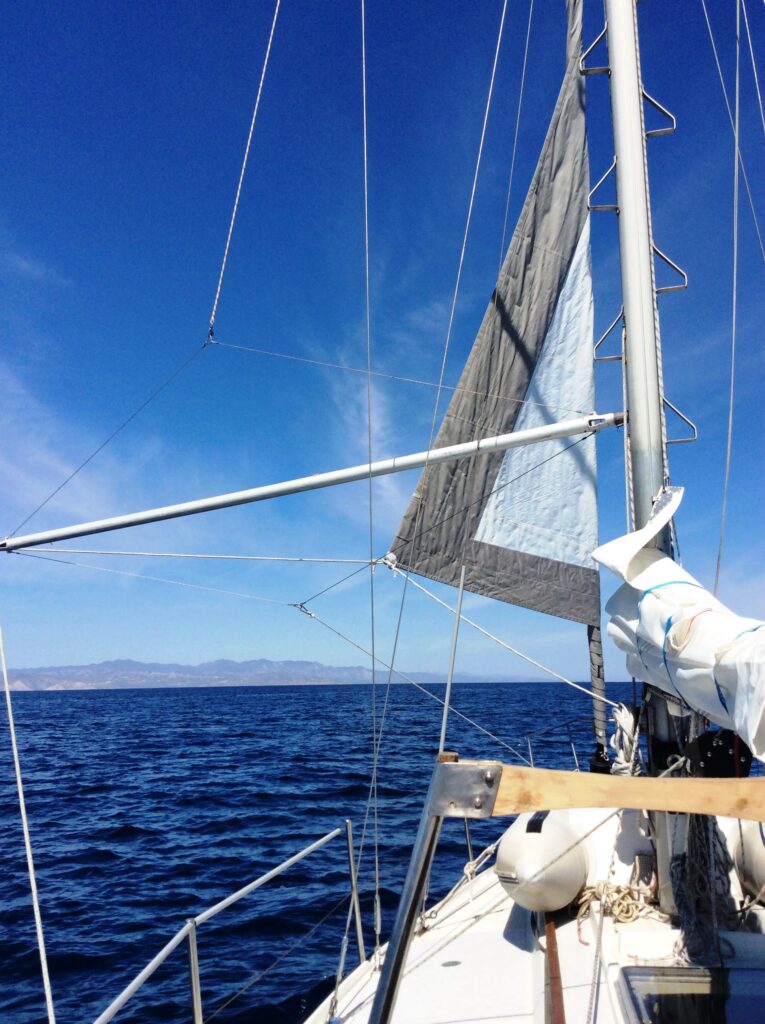
- Prevents the headsail from continuously collapsing and refilling
- Necessary to carry a whisker or spinnaker pole on deck along with additional lines and rigging
- Takes more time to jibe (not a good idea if you need to maneuver in tight areas)
How to jibe with a poled-out headsail
- Furl the headsail. We don’t recommend gybing with the headsail up. A lot can go wrong with a heavy pole swinging around and several lines on deck.
- Unclip the pole from the genoa sheet
- Rotate the outboard end of the pole to the other side of the boat. If you’re using a spinnaker pole, you’ll likely have to unclip the inboard end as well to bring the pole through before clipping in on the new side.
- Clip to the opposite genoa sheet
- Unfurl the headsail and trim.
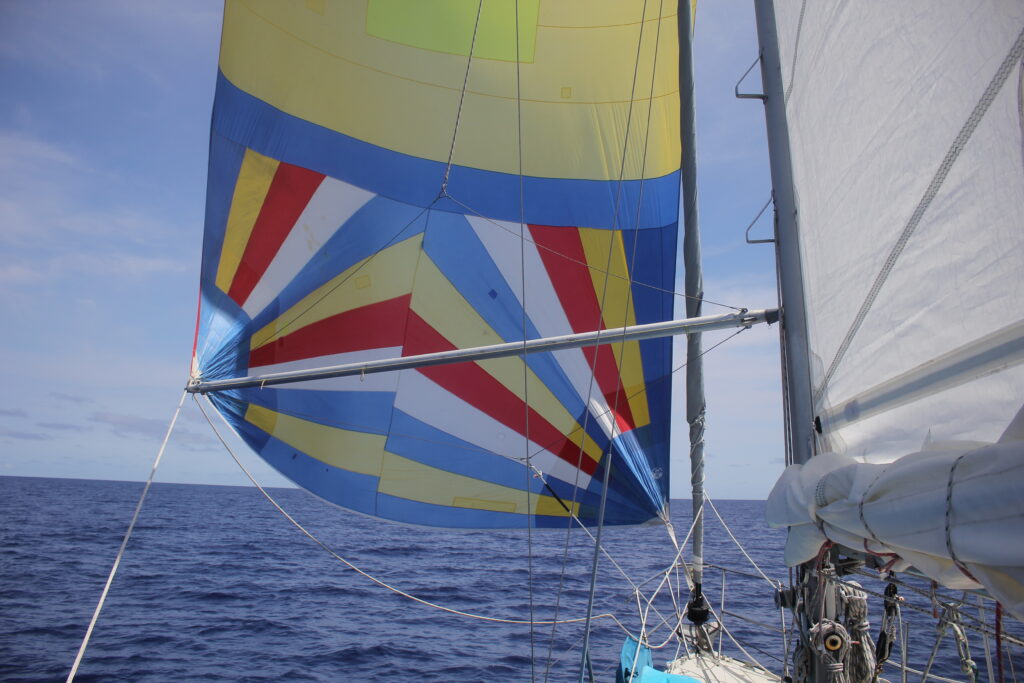
3. Downwind sailing with a spinnaker
My happiest days of ocean sailing were when we had light winds, no swell, and could coast all day long on our asymmetric spinnaker. It took us a while to build up the confidence to use ours but it eventually became second nature.
That being said spinnakers are more challenging to use than a furling headsail. They require constant attention to steering and trimming—It’s certainly NOT a case of “set it and forget it”.
It’s also important to have good communication amongst the crew. Discuss your plan (and who’s doing what) for launching, gybing, and dousing before you start.
Spinnakers vs. gennakers
A gennaker (a.k.a asymmetrical spinnaker or cruising chute) is larger than a genoa but smaller than a symmetric spinnaker, and performance-wise you can think of it as a blend between the two.
It does best between 80 and 120 degrees off the apparent wind, from just forward of the beam to a broad reach.
Most bluewater cruisers carry asymmetrical spinnakers because they can be pointed higher and are less work for short-handed crews.
At higher points of sail (e.g., a beam reach) the tack is attached to the foredeck and the gennaker is trimmed like a genoa.
On a run, we would pole our gennaker out to windward like a genoa, but it’s also possible to fly a gennaker like a spinnaker (tack to pole, clew to sheet).
How to rig a gennaker
- Secure the sail bag on the foredeck.
- Attach the tack to the stem head (the most forward point on the boat) with a 2-foot line. You may need a slightly different length depending on the size of your sail and rigging. Another option is to run a tack line from the tack to a block at the forestay fitting and back so that you can adjust the height of the tack above the deck (anywhere from 2 to 6 feet).
- Attach the spinnaker halyard to the head of the sail.
- Attach sheets to the clew, leading the lazy sheet in front of the headstay. Run both sheets back to winches and cleats.
- Head onto a broad reach.
- Hoist the sail quickly while keeping the sheet eased.
- Bring in the spinnaker sheet until the gennaker fills. You may need to head up slightly.
- Trim the sail as needed.
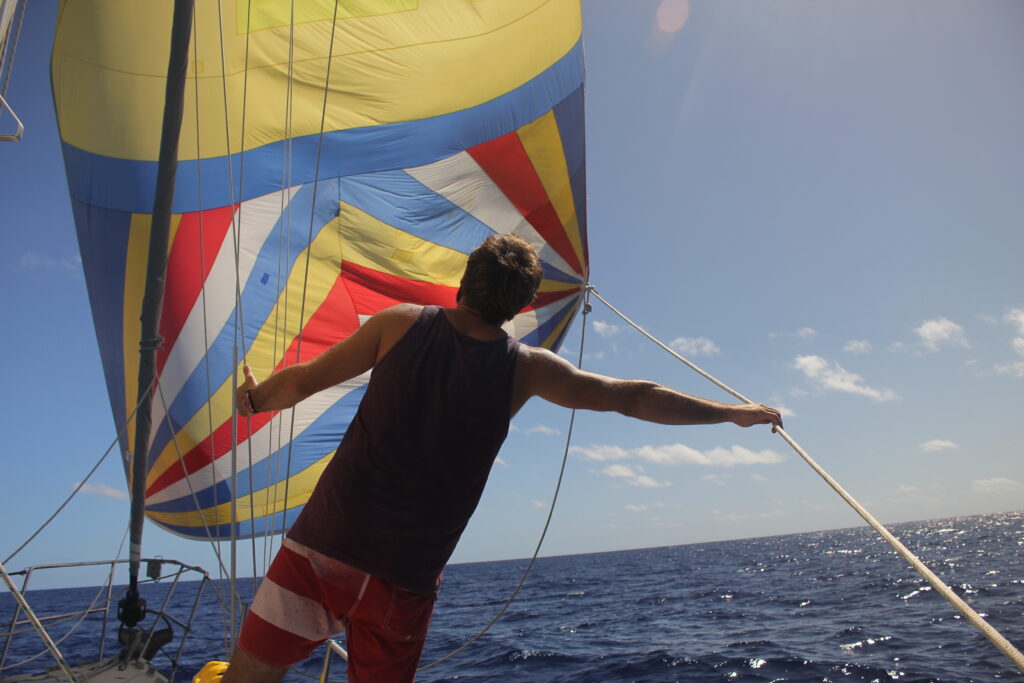
How to jibe the gennaker
When setting up, be sure to lead the windward sheet around the forestay in front of the sail and keep the lazy sheet (whichever one is not being used) out of the water.
- Slowly bear off and ease the sheet, using the wind pressure to get the sail out in front of the boat.
- As the boat passes through dead downwind, release the old sheet and use the new sheet to pull the sail in front of the forestay to the other side.
- Head up and bring in the sheet until the gennaker fills.
How to take down the gennaker
Spinnaker sailing can be so much fun that it’s easy to keep the sail up longer than you should. This is what happened when I blew out our spinnaker on a crossing from New Caledonia to Australia.
Sadly the damage was well beyond anything I could patch up with my onboard sail repair kit . Pay close attention to the wind strength and always douse your spinnaker well before you need to.
We never used a snuffer to help tame our spinnaker but many cruisers swear by them.
Racers have devised a few ways to douse a spinnaker , but we found the following method was the best way for us as cruisers.
- Head onto a broad reach so that the mainsail blankets the gennaker.
- Ease the sheet until the gennaker collapses or has a big curl.
- Release the halyard in a quick but controlled way while simultaneously gathering the spinnaker, hand over hand, keeping it out of the water. I always preferred to do this in a seated position as it feels more stable.
- Stuff the spinnaker into a sail bag on deck.
- When the sail is completely down, release the tack from the bow of the boat
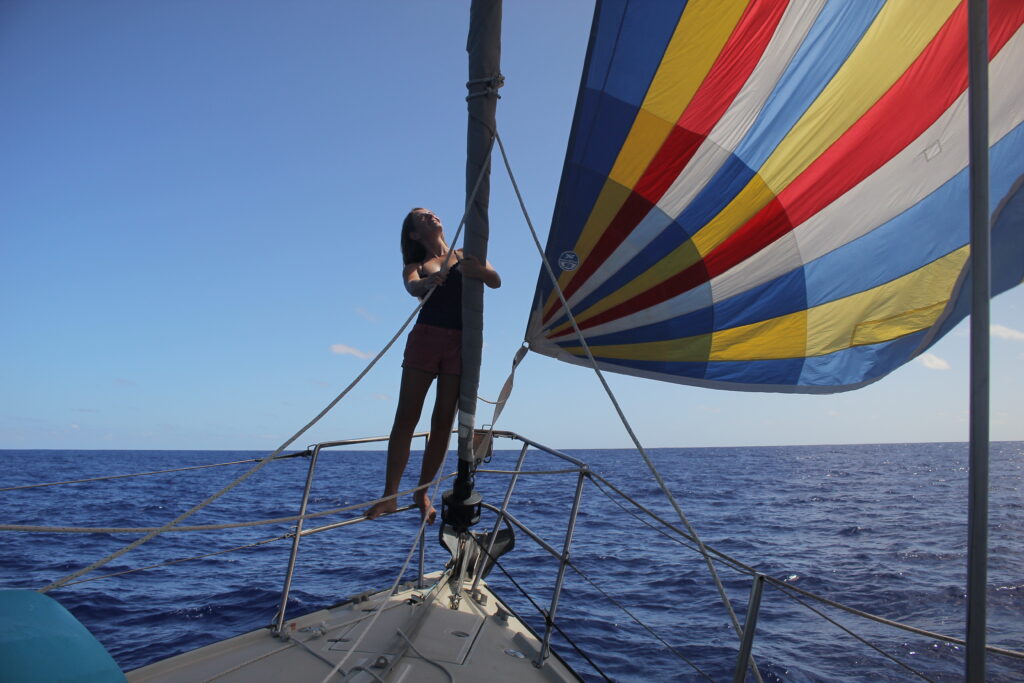
- Best speed in light air
- Lots of fun to sail
- Requires constant, active management (not great for short-handed crews)
- Slow and complex to launch, sail, and douse
- Not appropriate for sailing at night and in variable wind conditions
I hope you’ve enjoyed this post and that it helps you experience the joys of sailing downwind. “May the wind always be at your back.”
If you have any questions, drop us a line in the comment section.
Fiona McGlynn is an award-winning boating writer who created Waterborne as a place to learn about living aboard and traveling the world by sailboat. She has written for boating magazines including BoatUS, SAIL, Cruising World, and Good Old Boat. She’s also a contributing editor at Good Old Boat and BoatUS Magazine. In 2017, Fiona and her husband completed a 3-year, 13,000-mile voyage from Vancouver to Mexico to Australia on their 35-foot sailboat.
Terms and Conditions - Privacy Policy

Yachting World
- Digital Edition

SAIL FASTER SAIL SAFER advanced techniques series Part 2: Broaching
- March 1, 2016
In the second part of our 12-part series on advanced sailing techniques, professional sailor and coach Pip Hare guides you through what to do when you start to broach

Most of us will be familiar with that final pull on the helm that cannot be overcome as the boat rounds up to windward in a massive broach. The ensuing chaos can be hard to recover from, and damaging both for the boat and for crew morale.
Well-trimmed sails and keeping a close eye on conditions can help to avoid a lot of broaching situations. However, in this article and the accompanying video online I have drawn on my own experiences, both during solo ocean racing and when coaching mixed ability crews inshore, to highlight some key points on how to recognise the early warning signs of a broach.
See our video of SAIL FASTER SAIL SAFER Part 2
I look here at how to trim the sails to avoid losing control, as well as steering, crew interaction, what to do at night and when you are sailing short-handed.
Prompt action with mainsail trim can often be the simple answer to stop a tug on the helm from becoming a full wipe-out. On the first signs of a broach a quick ease of the kicker will twist off the top of the sail and so reduce the heeling moment.
When reaching in gusty conditions, the mainsail should always be well eased, traveller down, with a backwind ‘bubble’ at the mast as the default trim.
Make sure the kicker is in easy reach and if you are struggling to steer, place a crewmember next to it. If you often sail short-handed, think about leading the kicker to a position in the cockpit where it is more accessible. Double-ended systems are ideal.
If releasing the kicker does not reduce sufficient pressure on the helm, release the mainsheet until the boat comes back upright. All these actions will need to be done in quick succession, and as always it is good practice to make sure your mainsheet is kept flaked and ready to run out.
If you continually need to ease the main, then it is maybe time to reef; shortening the mainsail can make the boat easier to manage with less heel and often an insignificant loss of speed.
Broaching can occur under any sail plan; it is not a spinnaker-specific occurrence, though having the spinnaker up can make it a more intimidating experience.
If the mainsail cannot be depowered enough to prevent a broach, the spinnaker sheet is the only remaining ‘get out of jail’ line.
Top tips for short-handing Make sure all the crucial lines – kicker, mainsheet and spinnaker sheet – are within easy reach of the helm. Cross-winch across the cockpit if necessary. Put some luminous tape on the wheel so at night you can tell at a glance how much helm the autopilot is using.
Immediately ease out a large amount of spinnaker sheet until you feel the boat start to come upright or the helmsman tells you they have feeling back in the rudder. If you are using a lazy guy, ensure this will not catch on anything or prevent an ease.
Keep the spinnaker sheet eased until the boat is upright and starting to get back on course – an insufficient dump of the spinnaker sheet or bringing it back on too early will cause the boat to roll straight back into a broach every time it tries to recover.
When reaching under spinnaker be very sure not to let out the guy. This will make the situation worse as the pole will crash onto the forestay and the spinnaker will slew to leeward, heeling the boat even more.
A constant need to ease the spinnaker is probably an indication that it is time to take it down. As always, have the halyard flaked, ready to run and be ready to drop.
A broach can be averted by good communication between helmsman and crew. A first indication of a broach will be a marked increase in weather helm which it is difficult to steer against; at this point the helmsman must involve the crew.
The crew will not always know exactly how much kicker or sheet to let off and when, so to avoid all sails being dumped every time the boat heels over, the helmsman must keep the crew informed.
If, despite easing sheets, the boat continues to broach, pump the helm by bearing away hard, steering straight, then bearing away hard again. However, if you do not regain control you will get to a point where that is no longer effective. At this point, try putting the helm back to centre. With eased sheets and a little patience the boat should come upright and start to move forward, water will start flowing over the rudder and you will be able to steer downwind to avoid another broach.
If you are continually having to ease the sheet to avoid a broach, try steering a little lower or changing your sail plan.
Depower the main:
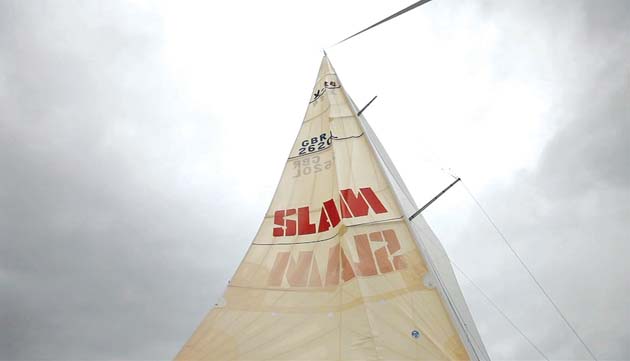
Ease the sheet:

Steer downwind:
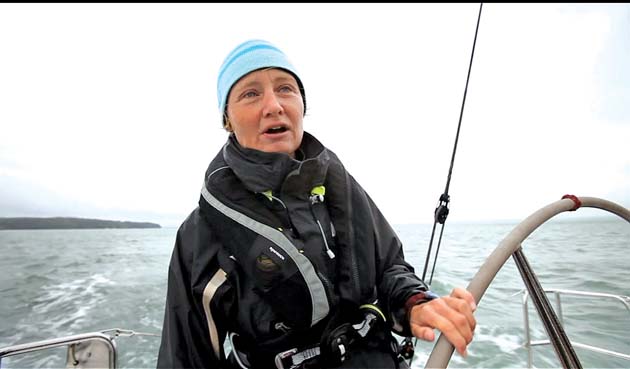
Trim sails to pilot:

Under autopilot
Autopilots are particularly sensitive to gusts and waves when reaching and so a change in conditions can cause the pilot to broach quite easily.
Keep an eye on how hard your pilot is working. As conditions worsen, increase response level to help it cope.
Trim the sails to the pilot and not the other way around. Think about taking in a reef earlier when using the pilot in potential broaching conditions – remember, it is not able to tell you to release the kicker.
Do’s and don’ts
- DO stay calm and keep talking
- DO ensure sheets are flaked and ready to run out
- DO practise reaching in gusty conditions to learn how quickly your boat responds
- DON’T shout
- DON’T ease the guy
- Be ready to reduce sail before you stop enjoying sailing

SAIL FASTER SAIL SAFER Part 3: Pip Hare describes how to gybe a spinnaker successfully
SEE ALL 12 PARTS HERE
12 part series in association with Pantaenius

Chinese Gybes – and how to avoid them
by Niclas | Jun 16, 2016 | boat handling | 4 comments
A “Chinese Gybe” (jibe) also known as a “death roll” is feared by many and we need to know how best to avoid them.
The scenario:
You’re sailing dead downwind in windy conditions, and suddenly the boat starts rolling back and forth with increasing amplitude to the point where the boat actually broaches to windward. As the boat is broaching to windward it is also turning sharply to leeward causing it to gybe uncontrolled – “crash gybe”.
See this excellent video clip which captures the action well:
This is quite common on dinghies and also on larger keel boats, especially when using spinnaker. Personally I’ve experienced it numerous times sailing dinghies but only a few times so far in a big boat (40 feet).
Can it also happen with Asymmetrical Spinnakers? Yep, as this lovely clip illustrates and also shows some great crew work recovering from the incident.
What’s the cause?
In order for the death roll to start you normally have a combination of all or most of the below:
- Sailing dead downwind or very close to it.
- Mainsail hasn’t got enough vang on, causing it to twist a lot, hence creating a sideway force.
- Spinnaker too loosely sheeted and not “strapped down”, allowing it to sway from one side to the other
- Boat (slightly) over-powered for the wind it’s sailing in
- Often gusty conditions
- Waves can also help trigger the death roll movements
What to bear in mind
So, what are the steps to take to avoid the rolling to begin?
- Bring on the Vang (also known as “Kicker” in Europe) of the Main very tight, not allowing the twist in the leech. The twist actually causes a resulting force at the top of the sail pointing sideways rather than forward. Note: This is different from when trying to avoid a broach when sailing on a reach, then you actually release the vang to ease power/pressure from the main.
- If there is a temporary wind gust, temporary set of waves or sail trim hasn’t been adjusted yet the quickest option is to steer up a bit avoiding the dead downwind course.
- The general advice is otherwise to steer to keep the boat under the top of the mast.
- Make sure the crew keeps the weight low, ie no unnecessary standing in the boat. Lowering the centre of gravity makes a huge difference.
- For the Spinnaker we need to bring on the Tweekers maximum , i.e. all the way down to the deck of the boat.
- The spinnaker sheet will also need to be sheeted harder than otherwise (when sailing dead downwind you no longer want the kite to be on the brink of falling in, the normal practice when reaching). You don’t want the spinnaker flying far from the bow of the boat allowing it to shift from one side to the other.
- The Spinnaker pole also needs to be strapped down using the kicker (downhaul) lines to further help control the movement of the kite.
- Let the Spinnaker pole forward a few feet more than you would have in calmer downwind conditions.
If the above actions didn’t seem to help and the tendency to start rolling is still there, well then maybe it’s time to go for a reef or a smaller Spinnaker or go to white sails only. Death rolls are never going to be fast in a racing situation.
If the death roll still happens what to do?
Firstly hang on to the boat for dear life, keeping your head low and avoiding the crashing boom. It is also very important to stay clear of the main sheet and main traveller!
Once the boat has gybed and is down on it’s side the crew needs to take action to get it upright again, and the priority is now to get the power out of the Spinnaker to allow the boat to be raised and also to minimise (further) damage to material or crew. I would suggest “smoking” the halyard, while keeping sheet and brace still on as the safest option which also enables the crew to get the sail in. I’m happy to be told better methods, comments are always welcome 🙂
Here’s some further video advice in the matter:
Share this:
Nice post. I learn something new and challenging on sites I stumbleupon on a daily basis. It will always be interesting to read content from other authors and practice something from other web sites.
Great article and the movie clip was a great teaching aid.
Strictly speaking what is described is a gybe broach. A Chinese gybe originally meant when the top half of the main gybes but the top of the sail doesn’t, caused by a boom vang breaking or being very loose.
Great article, the video is very helpful
Blogroll - Sailing blogs
- Americas Cup info site
- Sailing World Magazine
Rules and regulations
- RORC, including the IRC handicap rule
- The rules of racing
Sailing organisations
- Americas Cup
- Australian Olympic sailing team
- International Canoe Sailing Organisation
- International Sailing Federation
- Yachting Australia
tips and tricks
- Sailing world experts section
- boat handling
- sailing basics
- Sydney sailing

How to Avoid a Gybe Broach – Video Tutorial
When sailing dead downwind in heavy air on a boat with a symmetrical spinnaker, control of the boat eventually will become a problem. One wrong wave, an unexpected puff or momentary loss of concentration by the helmsperson can lead to a gybe broach. This video will give you tips on how to avoid a dangerous, boat breaking gybe broach.
To start with, you can’t sail the boat the same way in heavy air as you do in more moderate conditions. You have to trim the sails tighter and sail as much as 10-20 degrees higher than dead downwind. To reduce the chances of a wipe out, you need to prevent the boat from heeling to windward. When the boat heels to windward, the center of effort shifts to windward, forcing to boat to turn to leeward.
At high speeds this can make the boat uncontrollable because an attempt to correct the course results in the rudder stalling. This video gives some tips to help prevent gybe broaches.
Video from UK Sailmakers YouTube Channel

How to Choose the Perfect Sailboat Tattoo Design for You
Five entertainment options on a sailboat, sailing nandji ep 349 is this place even real, 7 bluewater cruising sailboats we love, live your passion, subscribe to our mailing list.
Rounding up
Broaching, or rounding up, can occur on any type of boat on any point of sail, but it's most common when you're sailing off the wind. Rounding up occurs when a massive amount of weather helm (which we describe in Chapter 11) from all the forces acting on the boat causes the boat to "round up" swiftly toward the wind. In a round up, you feel as though the rudder is gone, because you have no steering control. Actually, the rudder is just stalled. Telltale signs — increasing weather helm and increasing heel — precede a round up. The following list provides a few ways to avoid this embarrassing (and potentially hazardous) fate when sailing on a windy reach:
1 Ease the boom vang. This tip is especially important when the boat is heeling so much that the boom is close to the water.
1 Move the crew weight back. This action keeps more of the rudder in the water. Make sure the crew is hiking, too.
1 Play the mainsheet aggressively. In big wind and waves, you must play the mainsail to keep the boat "on its feet." The helmsman should ask the trimmer (sometimes one and the same on a dinghy ) for a quick ease if he starts feeling weather helm building.
1 "Pump" the rudder. By rapidly jerking the helm from "straight" to "bearing away sharply" and then back to "straight," you may avoid stalling and help the rudder stay gripped to the water.
1 Reduce heel. See Chapter 11 and this chapter for ideas such as flattening your sails and pulling up your centerboard partway (if you have one).
If you do broach, make sure all the crew is still aboard and hanging on tight. Then put the helm to center, ease all the sails, and try, with what little forward motion you have left, to coax the boat back away from the wind again by jerking the rudder hard to bear off. If you're flying a spinnaker or an A-sail, you may need to take it down to get the boat back on its feet. Keep the guy (or tack rope on an A-sail) on tight and let the sheet out all the way so the sail luffs. You may have to drop the halyard and then pull the sail in from that remaining corner.
Rounding down
The round down, or death roll, is probably the most spectacular crash. It occurs most commonly on dinghies , resulting in a capsize, although keel-boats aren't totally immune. The round down starts with the boat sailing on a very broad reach, run, or by the lee (Chapter 5 covers the points of sail). In strong winds, if you let the spinnaker fly too far to windward of the boat, or if you heel the boat to windward with too much twist in the main, the boat can roll dramatically to windward while it turns "down," away from the wind direction. The forces start to multiply, and soon you've lost steering control. Rounding down can result in a dangerous accidental jibe.
The following preventive measures can help you avoid the death roll when sailing on a broad reach or run:
^ Don't let the mainsail out too far and keep the boom vang on tight. On this point of sail, you want to minimize mainsail twist.
^ Don't sail too low. Turn the boat toward the wind until you're clearly on a broad reach. The higher the better — to a point, because as you turn up you now risk a broach and may be steering way off course.
^ Keep your spinnaker pulling the boat forward, not to windward. If your spinnaker seems to have a mind of its own and is unstable, pull in on both the sheet and the guy to fly the spinnaker closer to the boat.
^ Keep the crew weight in the middle of the boat. Keep the crew weight balanced, and have your crew be ready to move quickly to leeward if the boat rolls that way.
If you do capsize in a dinghy, then we hope that you read all about getting out of this predicament in Chapter 7. On a keelboat, you end up on your side, like in a broach.
You don't have to jibe, ever; you can always turn the other direction by tacking and then bear off again (take down the spinnaker or A-sail first, please). In heavy air, try to minimize any jibes — planned or not. And if you do decide to jibe, remember to employ the S-turn technique, which we describe in Chapter 11.
Continue reading here: When you go aground
Was this article helpful?
Recommended Programs

Myboatplans 518 Boat Plans
Related Posts
- Setting an asymmetrical spinnaker
- Dropping the mainsail - Sailing Techniques
- Broaching - Sailing Procedures
- Changing course - Sailing Procedures
- Heading up and bearing away
- Identifying the types of buoys
Readers' Questions
How to stop a sailboat?
Heave-To: This is a maneuver used to slow a sailboat down. It’s done by backing one sail and luffing the other in order to create opposite forces that stop the boat from moving forward. Drop the Anchor: This will bring the boat to a stop quickly. You need to make sure that the anchor you use is appropriate for the type of bottom your boat is in, and that you have sufficient anchor rode attached. Furling: This is a process of rolling up one or more sails in order to reduce their effectiveness and slow the boat down. Deploy Drag Devices: Deploying specialized drag devices such as sea anchors and drogues is a great way to slow a sailboat down. These are usually deployed off the stern of the boat and will act as a brake against the water. Use the Motor: If your boat is equipped with an outboard motor, you can use it to stop the boat. This is usually best done in combination with one of the above methods such as furling the sails or deploying drag devices.
How to avoid death roll sailing?
Always wear a life jacket: It is important to wear a life jacket or personal flotation device (PFD) when sailing to help avoid drowning in the event of a death roll. Be aware of the conditions: Before venturing out, check the forecast and be aware of the potential hazards that could affect your boat’s stability, such as choppy waters, high winds, and strong currents. Load and balance your boat properly: Make sure to evenly distribute the weight of the passengers and cargo within the boat. This helps ensure that the boat maintains its center of gravity and stability. Use the appropriate safety gear: Ensure that the boat has the necessary safety gear, such as an anchor, flares, and a first aid kit. Increase your knowledge: Take classes or courses to increase your skillset for handling boats and navigating in challenging conditions.
“Fair winds and following seas.” This popular phrase is often said to boaters embarking on a journey (or even just going out to a favorite fishing spot from a private boat dock rental). It’s meant as a token of good luck. However, a “following sea” can turn dangerous under the right (or rather, wrong) conditions. Let’s discuss.
Traveling in a “following sea,” means the waves are rolling in the same direction that the boat is going. This situation would seem safe enough, and it usually is, as long as the waves aren’t rough and moving fast and there aren’t strong winds. However, it can lead to situations known as broaching or pitchpoling. Another time this could occur is when you’re following a boat throwing a large wake and you end up sailing/cruising up and over the “trough” and into the wake.
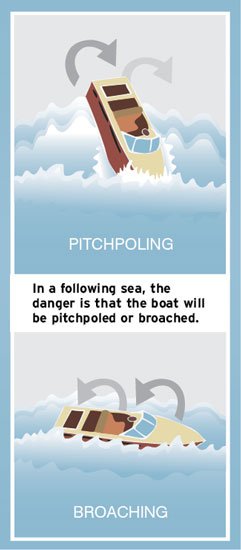
Pitchpoling
You don’t want to sail down the front of the wave (fun as that may sound – take our word for it, it’s not). This is called pitchpoling. Pitchpoling is when the bow of the boat “buries” its nose in the wake, or trough, of water. Then, the stern (back of the boat) flips up and the boat turns end-over-end like a cartwheel.
This appears to be a more common occurrence with sailboats when the rudder gets lifted out of the water, but of course, it can happen with any vessel. If the boat begins racing down the front of the wave, you’ll want to immediately throttle back so that it doesn’t capsize.
On the other hand, slipping to the side is called broaching. Essentially, the boat lists over to the side of the wave where it turns sideways and then rolls over (basically going sideways into the wave). Use the throttle and rudder to stay out of, or get out of, this situation.
If the water/waves are going faster than you, slow down and let the wave pass. Next, increase power until the next wave comes by. The use of trim tabs can also be helpful under these circumstances as you can trim the bow up and then ride on the back of the wave.
Never stop in following seas. If you stop, the waves can hit the transom, splash up and over and sink the vessel (this is more common in small boats but still bears saying).
It’s always good to follow safe boating practices and be aware of potentially dangerous situations such as running aground , boating at night or boating in hurricanes and other inclement weather before leaving a private boat slip for rent. Hopefully you’ve picked up some pointers on how to avoid pitchpoling and broaching. The next time you’re running in a following sea , you’ll know exactly what to do, or not to do, to get back to the marina or private boat lift rental safely.


- Forums New posts Unanswered threads Register Top Posts Email
- What's new New posts New Posts (legacy) Latest activity New media
- Media New media New comments
- Boat Info Downloads Weekly Quiz Topic FAQ 10000boatnames.com
- Classifieds Sell Your Boat Used Gear for Sale
- Parts General Marine Parts Hunter Beneteau Catalina MacGregor Oday
- Help Terms of Use Monday Mail Subscribe Monday Mail Unsubscribe

- Thread starter frank barbehenn
- Start date Jun 25, 2005
- Catalina Owner Forums
- Smaller Boats
frank barbehenn
I am novice, and need advice. What exactly is broaching and what conditions produce it? Does braoching require that the boat be heeling too far upwind, with loss of rudder control? And how does one come out of it? How does one determijne one is headed into a broach and stop it in time?
Bayard Gross
Broaching is where your mast runs into the water. Normally, this is only an issue with very high winds and sea, conditions that most likely you would avoid. As a general concept, the sails fill with so much wind, they literally knock the vessel over onto its side and therefore the mast goes into the water. The problem becomes whether the boat will right itself or not. Assuming you ease the sheets, and the cause for the broach, such as a sudden wind gust or a rouge wave, has dissipated, the vessel should right itself. However, if the wind continues strongly against the side of the vessel, seas continue to pound her, water starts to enter through the companionway, and you eased the sheets, assuming your rigging is still intact and not a pile of junk all over the deck, well, that’s that. Nevertheless, to avoid a broach, one must instantly ease the sheets. As far as the Catalina 25 is concerned, I think you’ll agree the factory mainsheet set up and factory horns or cam cleats for the jib sheets are poor. For the jib sheets, I would replace either the horns or factory cam cleats with Ronstan cam cleats that should release more easily. For the mainsheet, you’ll need to move the end of the sheet and its cam cleat to either a barney post or similar to the fashion I have on my Catalina 22 that for practical purposes is very similar to your Catalina 25. You can see my main sheet set up at: http://tinyurl.com/88t92
Not necessarily Broaching is basically when your boat gets sideways to the seas and you loose control. Most common occurrence is running downwind with the seas following. If the seas are large enough and moving faster than the boat they can cause the stern to try and pass the bow. When the boat is sideways to the waves you have no control with the rudder as you are not making any forward movement. This is a broach. The mast doesn't necessarily go into the water but can definitely lead to that. Avoiding a broach requires you having enough sail up to maintain control of the boat but no so much as to overpower it. A big rudder helps too.
Broach Here is the definition from Marisafe: Broach- sudden, unplanned and uncontrolled turning so that the hull is broadside to the seas or wind Web site for definitions: http://www.marisafe.com/resources/boatdictionary.asp?vmcid=41&vmpid=16
Broaching normally occurs when sailing off the wind in gusty conditions. The gusts cause excessive heel and sudden bursts of weather helm, putting the vessel out of balance. The boat will start to spin out of control as it tries to round up into the wind. In heavy seas the beam-to exposure to the waves may lead to a capsize/knockdown. To avoid broaching, try to anticipate those sudden increases in weather helm and try to keep the boat flat, as in not heeling. Use the foredeck's relationship to the horizon for reference. Needless to say, you should reduce sail if the boat feels difficult to control. If the boat starts to round up, straighten the helm quickly to reattach flow and collapse the sails to pop the boat upright. Once the boat straightens up you should use the remaining speed to bear off on a broad reach so you don't round up again or jibe-broach. Re trim the sails front to back.
when you say collapse the sails what do you mean? There is no time to drop the sails. If you are going downwind and rounding up, the sails are already let out. So what do you mean? Thanks for the clarification.
collapsing the sails.. Sorry, that might be confusing. I just mean to spill the air out of them, which means you'll certainly have to release the vang and sheet on the main and let the spinnaker halyard and guy go a bit until the sails are depowered. Reattching the flow to the rudder is utmost, most of us will keep pulling to offset the heavy weather helm. My teachers recommend putting the rudder amidship and dumping the air out of the sails until control is regained.
Broaching/Knockdown. I've been there. My C22 swing keel, had her sails flat in the water. The sails were still cleated & she didn't want to right herself until I swam around & pulled down on the keel. The keel of course was parallel with the water & too high to reach easily. I have long arms! As soon as the vaccum between the sails & the water was broken, up she came. Because the sails were still cleated she took off like a rocket. (almost) When floating on her side, the water was not close to entering the companionway as the boat floats really high. The keel was not locked down. Regards, Bob B.
- This site uses cookies to help personalise content, tailor your experience and to keep you logged in if you register. By continuing to use this site, you are consenting to our use of cookies. Accept Learn more…
- Share full article
Advertisement
Supported by
Guide to Avoid Broaching
By Barbara Lloyd
- July 11, 1988
DURING a New York Yacht Club regatta in Newport, R.I. in May, a fleet of racing boats encountered a cruise ship barreling along at about 15 knots. The ship kept bearing down, appearing not to change course. The sailboats had to move fast to get out of the way. And since they were all flying spinnakers, it was no easy task. Several boats broached in a mass of quivering rigs and thrashing sails.
Other than sinking, broaching can create one of sailing's most hair-raising moments. Broaching is when the boat heels too far to one side, or capsizes. The boat falls on its ear, its bow driving into the direction of the wind. The mast tips sideways, forcing its sails to sweep the water's surface or submerge. A broach can shred sails and toss crewmen overboard.
A keelboat usually will right itself because the keel acts as a counterweight; a multihull will stay upside down. In either case, there are ways to prevent a broach, or stop it before it gets out of control.
Steve Colgate, founder of the Offshore Sailing School based in City Island, N.Y., said that students live in fear of broaching. ''It is probably one of the most frightening situations because they don't know how it's happening or why,'' he said. ''Knowledge helps to relieve much of the concern.''
In broaching, a sailboat usually is moving through one of two points of sail: a run, with the wind coming from behind, or a reach, where the wind comes at the boat broadside. Most often, the boat is carrying a spinnaker and sailing on a close reach.
A wave usually triggers a broach, but it can also come from a sudden puff of wind or change in the wind's direction. When the boat starts rolling from side to side under spinnaker, the next errant wave may disturb the delicate balance between the boat and the power in its sails. If the rudder rises out of the water in heeling, there is no steering left in the helm and the boat sails out of control.
Preventive measures vary with the size and type of boat, but there are basic rules. Colgate suggests these guidelines: Let out the mainsheet immediately if the boat begins to round up into the wind; keep the boat as flat as possible in the water by having the crew sit on the windward rail; make sure you use the right size sails for specific wind conditions so as not to overpower the boat.
On more sophisticated boats, such as those that carry additional adjustments for the rig, Colgate has these tips:
If you're sailing in conditions that could force a broach - in rough seas or high winds - keep the backstay on downwind rather than letting it run free. This bends the mast and depowers the mainsail by freeing the leech.
If the boat has a boom vang, release the vang to stop a broach rather than easing the mainsheet. This is a quicker adjustment. It allows the end of the boom to ride up, forcing the top part of the mainsail, where most of the power is in the sail, to fall off to leeward first.
Select a flat spinnaker for reaching conditions rather than the fuller sail you would tend to use while sailing downwind. Keep the halyard tension tight to keep excessive fullness out of the sail. ''This is not the right time to start playing with halyard ease,'' said Colgate, referring to a racing tactic for getting more power out of a sail.
Keep the weight of the crew aft in the boat. Weight forward tends to force the bow of the boat down, a condition that can contribute to broaching by creating weather helm - the tendency of a sailboat to turn its bow to windward.
Richard Konkolski, an offshore sailor who has logged more than 150,000 miles at sea alone, cannot count the number of times he has broached by turning the boat on its side. Konkolski defected six years ago on a boat from Czechoslovakia and now lives in Newport, R.I.
He pushes his boats hard, but he knows how to be cautious.
''You mostly broach because you are carrying too much sail,'' Konkolski said. ''The trick is to keep good control of the sails and good control of the steering. You have to pay full attention to the spinnaker - to the direction of the wind, to the gusts, and to the sea.''
Konkolski considers the helmsman the most important person on a boat. An experienced helmsman will guide the boat down the face of the wave rather than letting it hit at an angle where the wave will roll the boat. He is then quick to steer back on course.
Broach Sailing: Mastering the Art of Controlling Your Boat
by Emma Sullivan | Jul 27, 2023 | Sailboat Gear and Equipment
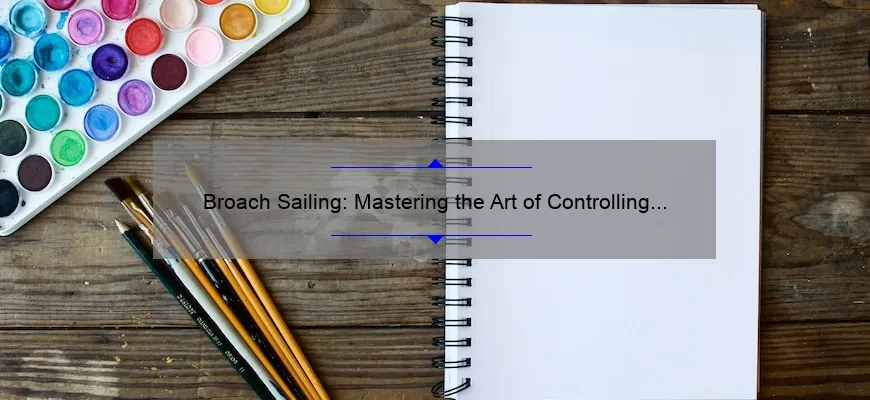
Short answer: Broach sailing
Broach sailing is a dangerous situation that occurs when a sailboat suddenly turns sideways to the wind, resulting in a loss of control. This can be caused by various factors such as excessive wind, improper sail trim, or sudden changes in boat speed or direction. It is crucial for sailors to maintain proper control and take preventive actions like reducing sail area or adjusting course to avoid broaching.
What is Broach Sailing and How Does it Happen?
Sailing aficionados are no strangers to the thrill of riding the waves, feeling the wind in their sails, and experiencing the sheer joy of gliding effortlessly across the water. However, there is one aspect of sailing that brings a unique blend of excitement and challenge: broach sailing.
So, what exactly is broach sailing? Well, picture yourself on a sailboat with your main sail fully extended, harnessing the power of the wind to propel you forward. Suddenly, a gust of wind strikes at just the wrong angle, catching your boat off guard and causing it to quickly heel over. As a result, your boat loses its grip on the water and spins out of control into an unintentional beam reach or even potentially capsizes – this phenomenon is known as a broach.
Broaching can happen when sailing downwind or reaching with strong winds or steep waves. It occurs when significant forces are applied to one side of the yacht’s sails rather than being evenly distributed between both sides. This imbalance can induce an uncontrollable rounding-up motion where your boat pivots sharply around its leeward edge. In simpler terms, imagine feeling as if you’re riding a wild rollercoaster on water!
Now that we have defined broaching let’s dive into how it happens. Broaching often transpires due to several factors including excessive heel angle caused by sudden gusts of wind or changes in sea state. Asymmetric spinnakers are particularly prone to initiating a broach due to their propensity for generating more sideways force compared to symmetric spinnakers.
When confronted with these challenging conditions that lead to broaching, skilled sailors employ various techniques and maneuvers to regain control swiftly and safely. One common method employed is easing out (or releasing) the sheets – which control how tightly or loosely your sails are set – thus allowing some excess wind pressure to escape from the sails’ surface area and reduce drag.
Another clever technique used by experienced sailors is altering their course or changing their heading. By steering either upwind or downwind, depending on the situation, sailors can redistribute the wind force more evenly across the boat and counteract the broach.
In situations where a broach becomes inevitable, well-prepared sailors may deploy a series of preventive measures called “broach recovery.” This procedure entails release of the headsail sheet instantaneously to reduce weather helm – a condition that causes excessive pressure on the rudder resulting in losing control. Additionally, skilled helmsmen will often use correct sail trim and careful weighting distribution to avoid swaying imbalance during intense sailing conditions.
With all these skills and techniques, you might wonder why anyone would even attempt broaching by choice. Well, for some daring sailors, it’s about pushing their limits and testing their abilities. Broaching provides an exhilarating challenge that demands quick thinking, exceptional skill, and precise timing to bring you back in harmony with the elements.
However dramatic and thrilling as it may be, broaching is no laughing matter. It requires considerable experience to navigate this wild ride safely. That said, for those who have mastered the art of sailing and possess a taste for adventure, broaching allows them to tap into an experience unlike any other.
So next time you find yourself out on the water pursuing your sailing dreams, keep an eye open for those gusty winds and challenging sea states; because who knows when you might encounter the heart-pounding phenomenon of broaching – where precision meets chaos!
Mastering Broach Sailing: A Step-by-Step Guide for Sailors
Ah, the thrill of sailing! The wind in your hair, the open sea calling your name – nothing compares to the freedom and exhilaration that sailing brings. But even the most experienced sailors can face challenges on their voyages, and one such challenge is known as broach sailing. Fear not, intrepid sailor! In this comprehensive guide, we will delve into the art of broach sailing, providing you with step-by-step instructions to master this technique and navigate through it like a pro.
So, what exactly is broach sailing? Well, imagine this scenario: you’re cruising along smoothly when suddenly a gust of wind hits your sails at just the wrong angle. Your boat heels over excessively and starts to round up into the wind uncontrollably. This is called a broach – a sudden loss of control that can be alarming for even seasoned sailors. But fear not! With our guide in hand, you’ll learn how to turn this potentially dangerous situation into an opportunity for skillful maneuvering.
Step 1: Recognizing the Signs The first key to mastering broach sailing is recognizing when it’s about to happen. Keep a keen eye on your boat’s behavior – if you notice excessive heeling or overspill from the top of your sails, these are often telltale signs that a broach is imminent. Stay alert and prepare yourself mentally for what’s about to come.
Step 2: Take Action As soon as you sense that dreaded tilt and start losing control, it’s time to take action quickly but calmly. The instinctual reaction might be to panic or freeze up, but remember – confidence conquers crises! Start by easing out or releasing tension from your mainsail sheet. This will help depower the boat by reducing its angle of attack against the wind.
Step 3: Balance and Trim Next, focus on balancing the boat. Move your weight and crew members towards the windward side of the vessel to counteract the excess heeling. Simultaneously, trim your sails by pulling in the headsail sheet to regain control over your yacht’s direction. This combination of weight shifting and trimming will help bring your sailboat back into equilibrium.
Step 4: Feather Your Sails Once you’ve regained stability, it’s crucial to feather or edge your sails to prevent a subsequent broach. Feathering means pointing your bow away from the wind slightly, finding that sweet spot where just enough wind fills out your sails without overpowering them. Adjust the angle gradually until you achieve balance and maintain a controlled course.
Step 5: Practice Makes Perfect Broach sailing requires practice to perfect; it’s an essential skill in a sailor’s repertoire. Find opportunities to practice in safe conditions with moderate winds and ample space around you. Familiarize yourself with how different boats handle broaching situations – each vessel might respond differently, so understanding yours thoroughly is key.
In conclusion, mastering broach sailing is a journey encompassing knowledge, skills, and experience honed through careful preparation and practice. By following this step-by-step guide, sailors can confidently navigate through broaches while ensuring their safety at sea. So get out there and embark on this exciting challenge – when it comes to mastering broach sailing, you’ll be well-equipped for whatever challenges come your way on the open water!
Frequently Asked Questions about Broach Sailing Answered
Introduction:
Broach Sailing is a thrilling and exhilarating activity that combines the art of sailing with the thrill of overcoming challenging conditions. It involves intentionally making your boat heel to an extreme angle, almost tipping over, before skillfully recovering control. This technique is used by experienced sailors to push their limits and enhance their skills. If you’re new to Broach Sailing or have some burning questions about it, fear not! In this blog post, we will provide detailed answers to some frequently asked questions about Broach Sailing.
1. What is Broach Sailing?
Broach Sailing is a maneuver where a sailboat suddenly loses control and skids sideways due to various factors such as strong winds, improper handling, or misjudgment of waves. It can happen unexpectedly, but seasoned sailors employ this technique intentionally to test their skills and responsiveness on the water.
2. Why would anyone want to intentionally broach?
Excellent question! Intentional broaching allows sailors to develop crucial skills such as recovery techniques, improvisation under pressure, and understanding the limits of both their abilities and their vessel. Broaching provides a unique opportunity for mastering control in extreme conditions while experiencing an adrenaline rush like no other.
3. Is Broach Sailing dangerous?
While Broach Sailing can be considered risky if not executed properly or without adequate experience, it can also be managed safely in controlled circumstances with proper training and precautions in place. Safety should always be a priority when engaging in this activity.
4. How do you recover from a broached position?
Recovery from a broached position requires careful finesse combined with swift action. A skilled sailor will quickly depower the sails by releasing the sheets while employing appropriate steering techniques to regain control of the boat’s direction. The timing and coordination of these actions are critical in successfully recovering from a broached position.
5. Are there any specific sailboat designs suitable for Broach Sailing?
While any sailboat can potentially broach, some designs are more adept at handling these conditions. Boats with a relatively narrow beam and deep keels tend to recover better from a broached position. However, it’s essential to note that the suitability of a sailboat for broaching depends on various factors, including wind speed, sea state, and individual sailing skills.
6. How can I prepare myself for Broach Sailing?
Before attempting Broach Sailing, ensure you have a solid understanding of basic sailing maneuvers and boat handling techniques. Building experience through regular practice in non-extreme conditions will help you gain confidence and develop the necessary skills to handle broaching situations effectively.
7. Are there any safety measures one should take during Broach Sailing?
Absolutely! Safety should always be at the forefront during any type of sailing activity. When engaging in Broach Sailing, it is vital to wear appropriate safety gear such as life jackets or personal flotation devices (PFDs). Additionally, ensuring that all crew members understand emergency procedures and conducting regular maintenance checks on your vessel will further enhance safety while indulging in this exhilarating activity.
Conclusion:
Broach Sailing may seem daunting initially but offers an extraordinary opportunity for sailors seeking to test their mettle on the water. By embracing the thrill, mastering recovery techniques, and taking appropriate safety precautions, you can unlock a new level of excitement in your sailing adventures. Remember always to prioritize safety first and grow your skills gradually through deliberate practice and guidance from experienced sailors. Happy Broach Sailing!
The Science Behind Broach Sailing: Understanding the Physics
Broach sailing, the exhilarating yet dreaded maneuver that all sailors encounter at some point in their adventures on the water. It’s that moment when a boat suddenly loses control and violently veers sideways, tossing the crew off balance and creating a heart-stopping experience. But what exactly causes this dramatic event to occur? To answer that question, we need to delve into the fascinating world of physics and uncover the science behind broach sailing.
At its core, broaching is caused by a combination of factors including wind force, sail design, hull shape, and weight distribution. Understanding these principles can help sailors predict and even prevent broaching from happening – ultimately enhancing safety and performance on the water.
Let’s start with wind force. As every sailor knows, it is the wind that propels their vessel forward. However, if not properly managed, it can also be their biggest adversary. Broaching occurs when a gust of wind hits a sailboat at an angle where it becomes unbalanced. The sudden increase in wind pressure on one side of the sails creates an imbalance in lateral forces acting on the boat.
But why does this imbalance result in such a violent sideways motion? To comprehend this phenomenon fully, we must consider sail design. Sails are engineered to harness the energy of the wind efficiently while maintaining stability. However, when subjected to excessive lateral forces during a broach situation, they can no longer provide adequate resistance to maintain equilibrium.
The next contributing factor is hull shape or form stability. A boat with more rounded hull sections tends to have less stability compared to one with sharper lines or flatter surfaces under water. During a broach, as lateral forces increase beyond what the keel or centerboard can counterbalance efficiently, water starts exerting an opposing force pushing against the boat’s direction of travel – exacerbating the uncontrolled sideways movement.
Lastly but equally pivotal is weight distribution within the vessel itself. In many instances, broaching occurs when the boat’s weight is not properly distributed. Excessive weight concentrated towards one side can unbalance the boat, making it more vulnerable to broach. This issue can be mitigated by ensuring a balanced load while considering factors such as crew position, equipment placement, and fuel or water tanks distribution.
So how can sailors prevent broaching or recover from it if it does happen? First and foremost, understanding the physics at play is crucial for prevention. By being aware of wind conditions, sail trim, and maintaining an appropriate heel angle, sailors can significantly reduce the risk of broaching. Additionally, adjusting sail plan or reefing ahead of time in changing weather conditions can also help maintain control.
However, if a broach does occur, quick action must be taken. Releasing the sheets (lines attached to sails) immediately can relieve pressure on the rigging and possibly allow the sails to luff – reducing their power and regaining control. Steering downwind can also assist in correcting the sideways motion by aligning the boat with the direction of wind pressure.
In conclusion, broaching is an exciting yet unpredictable aspect of sailing. While its occurrence may strike fear into even experienced sailors’ hearts, understanding the underlying physics behind this phenomenon empowers them to anticipate and react effectively. Through careful consideration of wind force, sail design, hull shape, and weight distribution – combined with proactive adjustments and quick reactions – sailors can tame this spontaneous monster at sea called broach sailing!
Top Tips to Prevent or Recover from a Broach while Sailing
Title: Mastering the Art of Sailing: Top Tips to Prevent or Recover from a Broach
Introduction: Smoothly gliding across the water, with nothing but the wind and waves propelling you onward, sailing is undoubtedly one of the most exhilarating experiences. However, even the most seasoned sailors are not immune to encountering unexpected challenges on their nautical journeys. Among these challenges is the dreaded broach – a sudden loss of control that can send your vessel tipping dangerously sideways. Fear not, intrepid sailor! In this guide, we will unveil our top tips for preventing or recovering from a broach while sailing.
1. Understand the Broach: Before delving into prevention and recovery strategies, it’s vital to grasp what exactly a broach entails. Picture this: your boat abruptly heels over due to excessive heel angle or an unbalanced sail configuration. The combination of strong gusts of wind and lack of counterbalancing forces leads to a dangerous situation where control is compromised. Recognizing when you are on the brink of a broach will significantly increase your chances for averting it successfully.
2. Feather Your Sails for Prevention: Preventing a broach requires finesse and quick thinking on your part as skipper. One effective technique is “feathering” your sails – easing them out slightly so that they catch less wind during gusty situations. A slight adjustment in your sail trim, coupled with careful attention paid to changing wind conditions, can be instrumental in maintaining stability and preventing potential disaster.
3. Mind Your Weight Distribution: Maintaining proper weight distribution among crew members plays a pivotal role in keeping your boat balanced against strong winds or rough seas that could initiate a broach episode. Remember to position crew members strategically within the boat – get them low and toward the leeward side during heeling moments to maximize stability.
4. Defending Against or Recovering from an Impending Broach: When disaster strikes and a broach appears imminent, it’s crucial to take swift action. If your boat starts to heel excessively, steer into the wind by turning downwind until the sails luff (flap) and depower. This maneuver will reduce heeling and help you regain control. Additionally, ease out the mainsheet to spill wind from the sails and reduce their effectiveness temporarily.
5. Practicing Prevention through Sail Trim: Mastering sail trim skills can be an integral part of both prevention and recovery strategies. Properly tuning your sails according to prevailing wind conditions optimizes your vessel’s performance and reduces the chances of encountering a broach. Remember: keep an eye on telltales fluttering smoothly – these indicators will guide you in achieving optimal sail set-up.
6. Be Mindful of Weighty Matters: Trimming your sails is not the only aspect involving weight distribution; ballasting also warrants attention when minimizing broach possibilities. Ensure water tanks or heavy equipment are stored low and closer to the middle of the boat while cruising, as this will contribute to overall stability.
7. The Art of Communication: Sailing should always be a collaborative effort between crew members, especially when tackling potential broaches head-on. Establish clear communication channels with all hands on deck before setting sail – this ensures that everyone understands their roles during unexpected challenges. Swift, efficient communication can often make all the difference in preventing or recovering from a broach seamlessly.
Conclusion: Remember, skill mastery is an ongoing process in sailing; even veteran sailors continually enhance their knowledge base to navigate uncharted waters successfully. By internalizing our top tips for preventing or recovering from a broach, you are arming yourself with invaluable knowledge that keeps you safe on any sailing adventure – smooth seas or turbulent currents alike! So hoist those sails high, unleash your adventurer spirit, and let nothing deter you from conquering every nautical domain!
Real-Life Experiences: Tales of Memorable Broach Sailing Moments
Ah, the exhilarating world of sailing! It’s hard to deny the irresistible allure of gliding across the open waters, harnessing the wind’s power to propel you forward. But every sailor knows that not every moment at sea is smooth sailing – broaching moments can turn an ordinary day into a heart-pumping adventure.
For those unfamiliar with the term, a broach occurs when a sailboat heaves violently onto its side due to a sudden gust of wind or other external factors. It’s like being on a rollercoaster ride in the middle of the ocean – thrilling and terrifying all at once.
In this blog post, we delve into real-life experiences shared by our fellow sailors who have encountered these memorable broach sailing moments. Strap yourself in and prepare for some riveting tales!
1. The Battle with Nature’s Fury Picture this: You’re peacefully cruising along pristine waters, feeling invincible as you conquer each wave. Suddenly, Mother Nature has another plan – a powerful gust appears out of nowhere, causing your boat to heel perilously close to tipping over without warning. In desperate attempts to regain control, adrenaline courses through your veins as you fight against nature’s mighty force.
Our sailor friend George had such an experience while participating in a racing regatta off the coast. Just as victory seemed within reach, a tempestuous squall hit his yacht head-on. The boat lurched wildly under the pressure, but George skillfully maneuvered it back on course just seconds before disaster struck. A heart-stopping moment turned into an unforgettable display of skill and courage.
2. Dancing with Waves Broaching doesn’t always have to be scary – sometimes it can become an impromptu dance routine on water! Jim recounts his amusing encounter as he battled waves during a family outing. As his boat caught an unexpected swell from behind, it lifted the stern high into the air, causing a momentary loss of control. Instead of panicking, Jim decided to go with the flow – literally.
With his family’s laughter echoing in the background, he transformed what could have been a nerve-wracking experience into a hilariously joyous dance with the waves. Twisting and twirling on his now sideways vessel, Jim showcased his ability to turn adversity into absolute delight. Who says sailing can’t be fun?
3. The Test of Resilience Broaching moments aren’t always limited to recreational sailors; professionals face them too. Take Margaret, a fierce competitor who participated in a grueling offshore race spanning several days and nights. Battling sleep deprivation and unpredictable weather conditions, she found herself confronted by an unexpected broach as darkness shrouded her yacht.
In this crucible of skill and determination, Margaret displayed unwavering resilience. Despite being tossed about like a tiny cork in an angry sea, she drew on years of experience to swiftly regain control of her boat. The incident became an indelible reminder that even under extreme circumstances, human capability and sheer willpower can overcome any challenge thrown their way.
No matter how unnerving or comedic these tales may seem on the surface, they all highlight one common thread – the indomitable spirit of sailors navigating through life’s unpredictable waters. Broaches are not mere mishaps but opportunities for personal growth and attaining mastery over one’s craft.
So next time you find yourself caught in the throes of a wild broach sailing moment, remember these stories from real-life adventurers who have turned chaos into triumph! And perhaps you’ll realize that within those fleeting seconds of terror lies uncharted territories where dreams are achieved and unforgettable memories are born. Happy sailing!
Recent Posts

- Sailboat Gear and Equipment
- Sailboat Lifestyle
- Sailboat Maintenance
- Sailboat Racing
- Sailboat Tips and Tricks
- Sailboat Types
- Sailing Adventures
- Sailing Destinations
- Sailing Safety
- Sailing Techniques

IMAGES
VIDEO
COMMENTS
This is when the boat broaches. A broach can happen when the boat is sailing in any direction: to windward, reaching, or when sailing downwind. A windward broach. When a boat is sailing to windward, the wind is coming over the bow at an angle of about 30 to 45 degrees. The wind speed is exerting a force on the sails.
A sailing broach refers to an unintentional and sudden loss of control by a sailboat, causing it to turn sharply into the wind. This can result in a dangerous situation, often leading to capsizing or loss of stability. It is crucial for sailors to understand and mitigate the factors that contribute to broaching, such as excessive heel, high ...
A broach is an abrupt, involuntary change in a vessel's course, towards the wind, resulting from loss of directional control, when the vessel's rudder becomes ineffective. This can be caused by wind or wave action. A wind gust can heel (lean) a sailing vessel, lifting its rudder out of the water. Both power and sailing vessels can broach when ...
A broach can happen as a resulting effects of wind or wave action. What is a Wind Broach? A wind broach happens when a boat is sailing downwind and the sail, often a spinnaker, is overpowered by a gust of wind. This causes the boat to heel (or lean) a yacht further than anticipated, causing the rudder to lift out of the water.
In the second part of our new 12-part series on Advanced Sailing Techniques, professional sailor Pip Hare coaches you through what to do when you start to br...
Sailing broaching occurs when a sailboat suddenly loses control and turns sideways to the wind or waves, causing it to heel excessively. This loss of control can be attributed to several factors, such as improper sail trim or adjustment, excessive wind force, boat design flaws, or even inexperienced handling by the helmsman. Causes: 1.
Short answer sailboat broach: A sailboat broach refers to a sudden and uncontrollable turning or heeling of a boat caused by the wind catching the sails incorrectly. This can lead to loss of control, capsizing, or a dangerous situation. Skilled sailors use various techniques to prevent or recover from a broach. Understanding the Sailboat Broach:
The first action is to release the kicker and mainsheet to allow the boom to rise and depower the mainsail. This allows the boat to come upright enough to give steerage. If the yacht is still on its side the spinnaker halyard can be eased about a third to half down, to take wind out of the sail but not too far.
Broaching. A broach is when a gust or a wave causes the boat to heel and twist violently into wind such that it can't be counteracted by steering. In extreme cases, this may cause the boat to capsize. There are a few strategies for avoiding a broach including not having too much sail area and carefully steering the boat to prevent rolling.
SAIL FASTER SAIL SAFER advanced techniques series Part 2: Broaching. In the second part of our 12-part series on advanced sailing techniques, professional sailor and coach Pip Hare guides you ...
As the boat is broaching to windward it is also turning sharply to leeward causing it to gybe uncontrolled - "crash gybe". See this excellent video clip which captures the action well: This is quite common on dinghies and also on larger keel boats, especially when using spinnaker. Personally I've experienced it numerous times sailing ...
When sailing dead downwind in heavy air on a boat with a symmetrical spinnaker, control of the boat eventually will become a problem. One wrong wave, an unexpected puff or momentary loss of concentration by the helmsperson can lead to a gybe broach. This video will give you tips on how to avoid a dangerous, boat breaking gybe broach.
Broaching. Broaching is when the boat turns violently to windward, out of control. It is most common when broad reaching or running but can happen on any point of sailing. A common cause of broaching is rolling, which gives the hull an assymetrical underwater shape causing the boat to move in the opposite direction to the way it is heeled (see ...
Short answer broach sailboat: A broach is a sudden and uncontrolled change in direction of a sailboat caused by a combination of strong wind, improper handling, or other factors. It occurs when the boat heaves to one side, causing loss of control and potential capsizing. Proper seamanship, trim adjustments, and responding promptly to changing conditions
When sailing dead downwind in heavy air on a boat with a symmetrical spinnaker, control of the boat eventually will become a problem. One wrong wave, an unex...
Broaching, or rounding up, can occur on any type of boat on any point of sail, but it's most common when you're sailing off the wind. Rounding up occurs when a massive amount of weather helm (which we describe in Chapter 11) from all the forces acting on the boat causes the boat to "round up" swiftly toward the wind.
This video shows what I do to recover from a broach or a wipeout when sailing in an Antrim 27 sailboat. Feel free to watch on a higher speed if the commentar...
If the boat begins racing down the front of the wave, you'll want to immediately throttle back so that it doesn't capsize. Broaching. On the other hand, slipping to the side is called broaching. Essentially, the boat lists over to the side of the wave where it turns sideways and then rolls over (basically going sideways into the wave).
Jun 26, 2005. #5. Broaching normally occurs when sailing off the wind in gusty conditions. The gusts cause excessive heel and sudden bursts of weather helm, putting the vessel out of balance. The boat will start to spin out of control as it tries to round up into the wind. In heavy seas the beam-to exposure to the waves may lead to a capsize ...
A broaching sailboat refers to a situation in sailing when the boat suddenly veers off course due to unexpected forces like wind or waves, causing it to lose control. This phenomenon can be dangerous and requires prompt action from the sailor to regain control of the vessel. Understanding the Concept of Broaching: A Comprehensive Guide for ...
In broaching, a sailboat usually is moving through one of two points of sail: a run, with the wind coming from behind, or a reach, where the wind comes at the boat broadside. Most often, the boat ...
Broach Sailing is a maneuver where a sailboat suddenly loses control and skids sideways due to various factors such as strong winds, improper handling, or misjudgment of waves. It can happen unexpectedly, but seasoned sailors employ this technique intentionally to test their skills and responsiveness on the water.
The barndoor rudders on a full keel boat are the least powerful. Broaching is often thought of as simply losing control either upwind or downwind. As others have said upwind its a nothing experience, the rudder stalls and the boat heads into the wind and the rudder is good to go again. When your rudder stalls down wind things get a hell of more ...